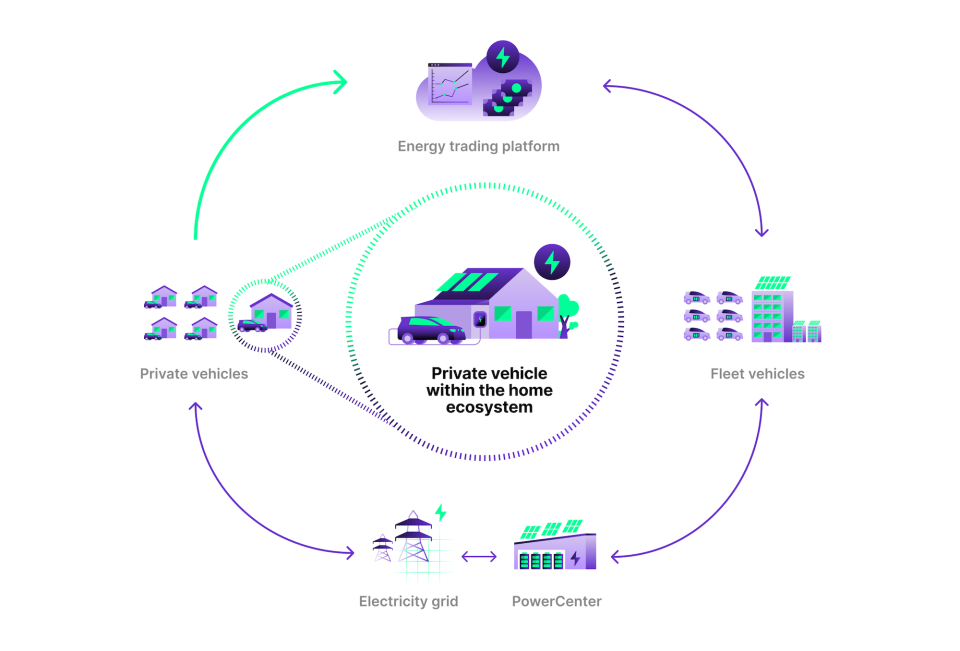Bidirectional charging – how your EV can power your home
Bidirectional charging turns your electric car into more than just a vehicle. It becomes an energy storage system for your home. This article will cover how bidirectional charging works and why it’s an important part of home energy management.
Imagine your electric car is not only your means of transport, but also a central part of your energy system. With bidirectional charging (bidi), this becomes reality: your vehicle can not only draw electricity, but also feed it back to supply your home with stored energy.
This technology is used in three areas:
Vehicle-to-Home (V2H): The EV supplies your home with electricity.
Vehicle-to-Grid (V2G): Stored energy is fed from the EV into the public grid.
Vehicle-to-Load (V2L): The EV serves as a mobile power bank for external devices.
Vehicle-to-Home (V2H) means using your EV as an energy storage unit for your home. The car connects to the home via a bidirectional charger and can feed stored electricity from its battery into the house when needed. This makes it possible to store excess solar power generated during the day and send it to the house in the evening when energy demand is higher. This is how households can optimize their self-consumption and reduce energy costs.
Vehicle-to-Grid (V2G) goes one step further: Here, the EVs is not only a storage unit for your home but also a flexible energy source for the public grid. Surplus energy from the car battery can be fed back into the grid during times of high demand. EVs act like decentralized energy storage units, helping stabilize the grid and better integrate renewable energy. In some cases, vehicle owners may even receive financial compensation.
Vehicle-to-Load (V2L) describes the use of the EV as a mobile power source for external devices. Through special sockets or adapters, laptops, household appliances, tools, or other electrical devices can be powered directly from the car. This feature is especially useful for camping, outdoor activities, construction sites, or emergencies when no other power supply is available.
Particularly exciting is the Vehicle-to-Home (V2H) option. It allows energy from the EV battery to be fed directly into your home. This not only changes how we use cars, but also how we think about energy.
How does Vehicle-to-Home work?
In conventional charging, electricity flows only one way: from the house into the car battery. With bidi, this one-way street becomes a two-way street. During the day, you charge your car either via the grid or ideally with self-generated solar power. When your home needs more energy than it produces, the car can feed electricity back into the home. Your EV becomes a mobile power storage unit, available whenever you need it.
This technology offers several advantages. First, it lets you increase the self-consumption of your photovoltaic system: surplus solar energy generated at midday doesn’t flow unused into the grid but is stored in the car and used in the evening. Second, V2H can help in exceptional situations – for example, as a backup power supply during a blackout. With a fully charged battery, many household appliances, lighting, or even heating systems can continue to run for hours or even days.
Why is it worth it?
The greatest benefit lies in independence. By storing and flexibly using your self-generated electricity, you reduce your reliance on the public grid – and cut your energy costs. Especially in times of rising prices, this can make a real difference. At the same time, you actively contribute to making renewable energy use more efficient.
Another plus is sustainability: You decide when your car charges and when it discharges. Combined with intelligent energy management systems, charging and discharging can be optimized to use greener and cheaper electricity. This not only saves money but also eases pressure on the grid.
What are the technical requirements?
Certain technical requirements must be met to make Vehicle-to-Home work. First, you need an EV that supports bidirectional charging. You also need a special charger capable of managing two-way electricity flow. Between the car and the home grid, an inverter ensures that the dc power stored in the battery is converted into ac power, which household devices can use.
Equally important is communication between EV, charger, and the home energy system. This is managed through intelligent control with Elli systems, in combination with an energy management system and automated, secure data exchange between car and charger via iso 15118. This interface, for example, ensures that your car is ready in the morning with a defined charge, while also supplying your home with surplus energy when you are at home.
A look into the future
Bidirectional charging and especially Vehicle-to-Home is still in its early stages in many regions, but development is progressing rapidly. More and more automakers are bringing vehicles with bidirectional charging capability to market, and charging infrastructure is also advancing. In countries like Japan, V2H is already being used in everyday life to make households more resilient and independent.
In the near future, EVs could supply not just individual households, but entire neighborhoods with energy. For homeowners with solar power generation, V2H will become an especially attractive solution: self-generated energy can be used more efficiently and cost-effectively.
With Elli, we are actively shaping this future, developing solutions that intelligently connect mobility and energy. Your car becomes a key building block of a sustainable, flexible, and future-proof energy system.
Elli bidirectional charging pilot
By combining solar power systems, home storage, and EVs, you can make optimal use of self-generated solar power, lower charging costs per vehicle and achieve energy independence from the grid
Let’s explore your individual potential together. Sounds good? Apply now and participate in our BiDi pilot! Learn more here.

